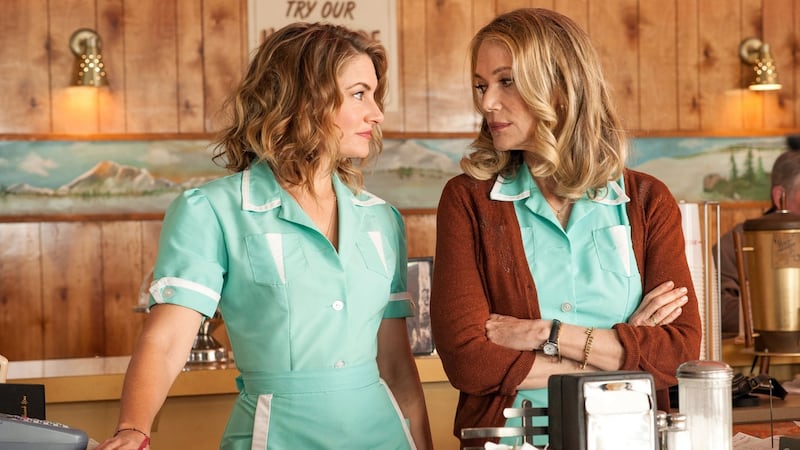About 30 minutes into the new series of Twin Peaks (Sky Atlantic, Monday, 2am/Tues, 9pm), a television phenomenon that has been awaited with both feverish anticipation and deepest worry, one young man explains his role. Sealed alone in a New York City loft, monitoring a large glass cage, he sums it up in an appropriately flat tone of voice: "I'm supposed to watch the box and see if anything appears inside." Viewers of Twin Peaks, back after an interval of almost 26 years, will know exactly how he feels.
The short-lived, never-forgotten and boundary-pushing TV series gave us many things: a plot McGuffin summed up by a tagline (“Who killed Laura Palmer?”); a time-warped sense of small-town Americana; and, in Kyle McLaughlan’s Agent Dale Cooper, a protagonist of coffee-and-cherry-pie appreciating wholesomeness whose journey was as much an investigation into a gallery of weird eccentrics, as a spirit quest through red-curtained antechambers and clues delivered by backwards-talking dwarves, giants and the deceased. It was exactly what would happen if you put David Lynch in charge of a TV show.
A surprising number of those features return in the premiere of the new series, again written by Lynch and co-creator Mark Frost. It is as glacially paced, contentedly wooden and painstakingly mystifying as a quarter of a century ago. In the Black Lodge – that liminal space of zig-zagging carpet, Venus-sculptures and utterly gnomic clues – we see the ethereal homecoming queen Laura Palmer, still young, telling the blank-faced Cooper: “I’ll see you again in 25 years.”
This may be a serious gesture to the show’s own mystic prescience, but it’s easier to take it as a gag. In almost every other respect, Lynch still seems to be making stuff up as he goes along.
Airing parts one and two together, because anything less might seem coherent, the new series typically refuses to settle down. A present-day Cooper, still confined to the Black Lodge, listens to a slow thicket of gibberish from the Giant and sombrely replies: “I understand.” (If spectral evil is one of the peaks, the other has always been self-reflexive comedy.)
In NYC, one sequence apes the signposted suspense, fatally exposed flesh, and much of the dialogue of a 1950s B-movie horror. Other scenes, in far-flung locations and goofily comic, are introduced then abruptly abandoned. Dale Cooper is fetchingly re-introduced, now with a raven mullet, a snakeskin shirt and a leather jacket, apparently the leader of a vicious gang. (This is actually his doppelganger, presumably inhabited by the malevolent spirit of Killer Bob.) And in Buckhorn, South Dakota, a ghoulish murder is discovered, and pinned early on the local school principal.
How these connect, of course, is considerably less involving than Lynch’s unhurried, denatured style: a campy aesthetic given deadpan delivery. With such a low signal-to-noise ratio (new viewers, itching for their smart phones, will wonder what, if anything, requires their attention), and a preference for the staginess of static medium-shots, Lynch tends either to hypnotise or frustrate his audience.
The dialogue is absurdist enough to qualify for a Eugène Ionesco play. The abrupt emotional range is sometimes worthy of a daytime soap (“I’ve known about this affair! You’re going down, Bill!”). And the performance styles range from very good actors who are deliberately acting badly, to very bad actors who are acting the best they can. (It achieves a fascinating, amusingly Lynchian balance.)

Any show that hands a considerable amount of exposition and instruction to a talking tree with a pulsating brain known as The Arm counts as essentially spoiler-proof. Suffice it to say that if, by the end of these re-introductory two hours, you can follow what is happening, then you haven’t been paying attention.
Devotees will have the swooning patience necessary to stick with Lynch's intermingling of dream states and the waking world – the only true location where Twin Peaks is set. Others can take solace from the words of Margaret Lanterman – The Log Lady – who returns with another tip-off from her pet piece of lumber and delivers a message that the death of her actor Catherine Coulson, shortly after filming, have made exquisitely poignant. "Hawk, watch carefully," she says, with some effort. "I'm too weak to go with you, but stop by. I have coffee and pie for you.
“Please let me know what happens.”












